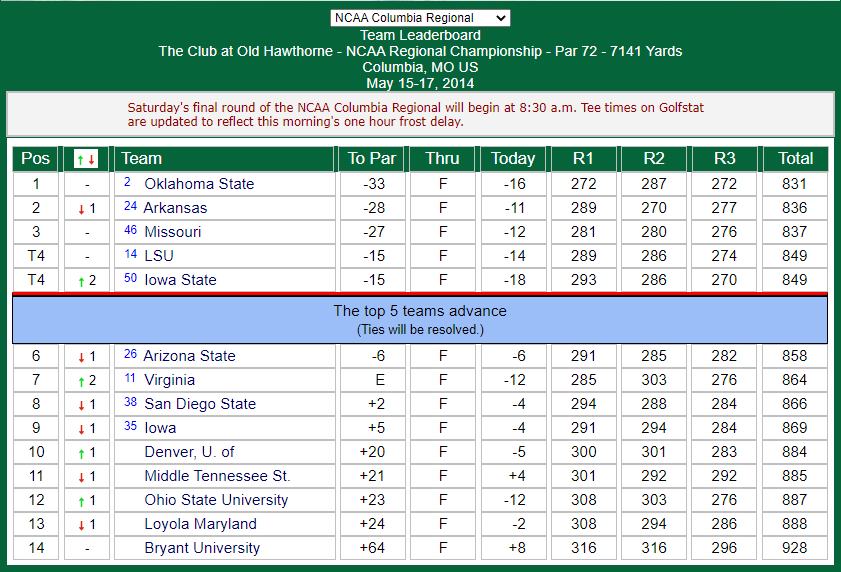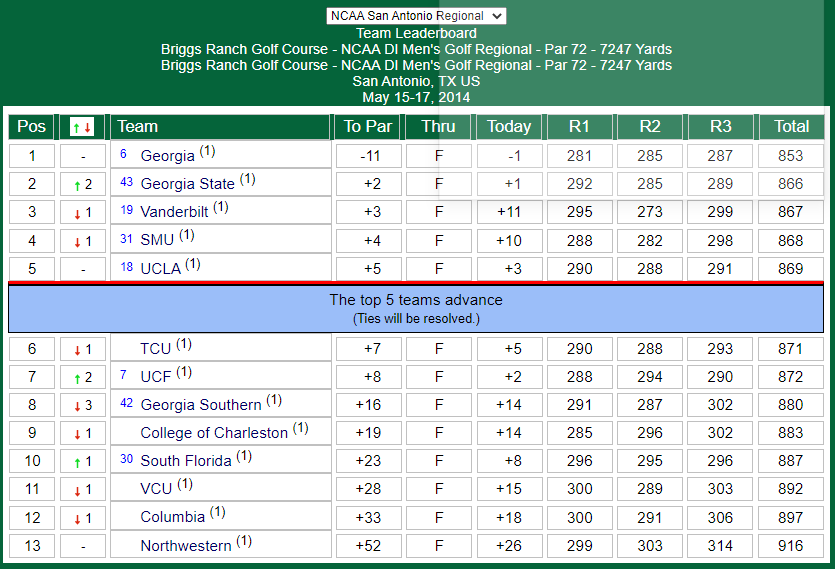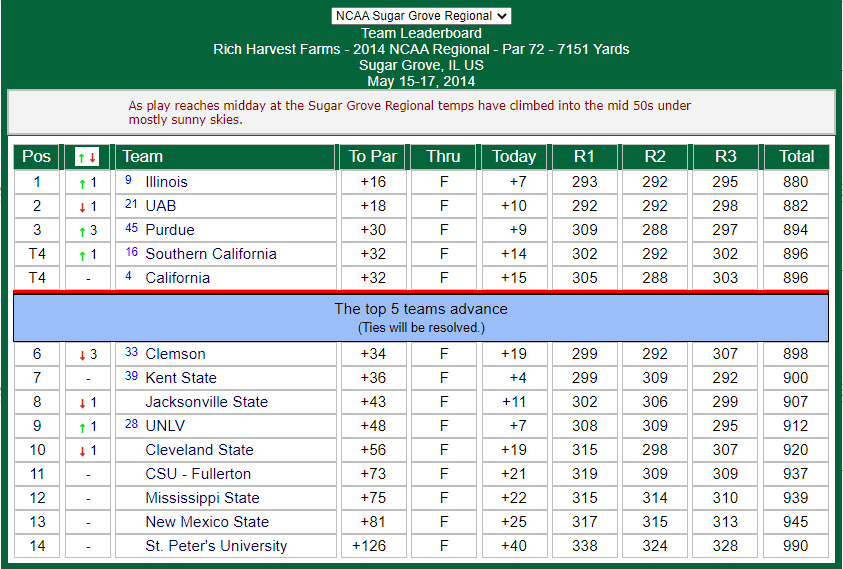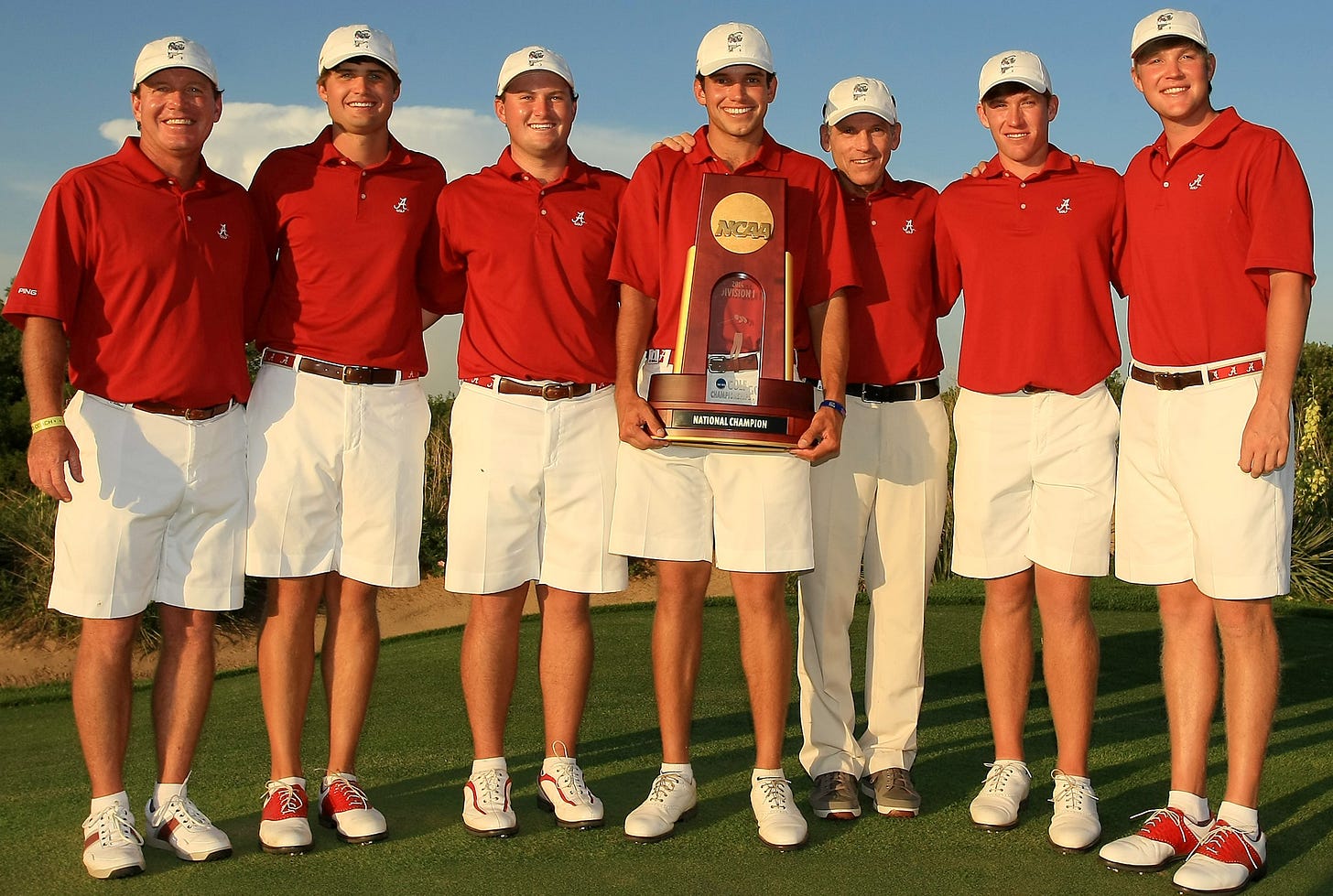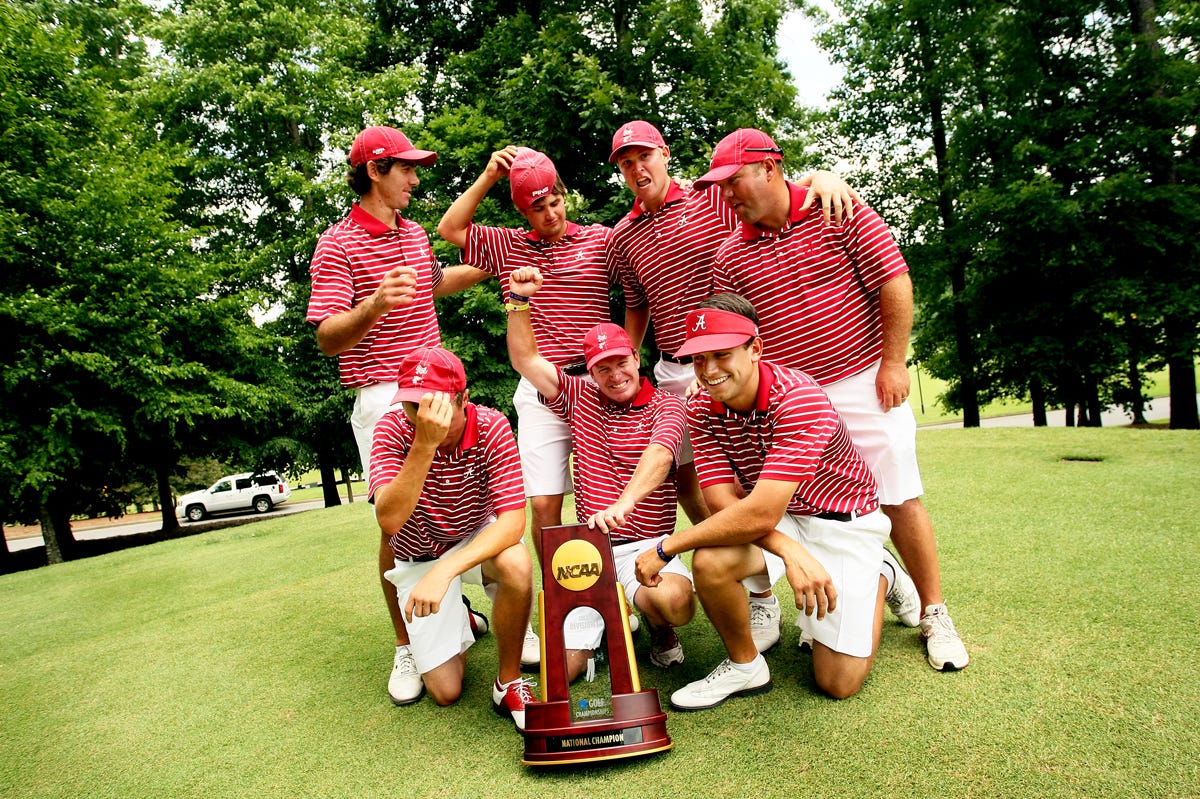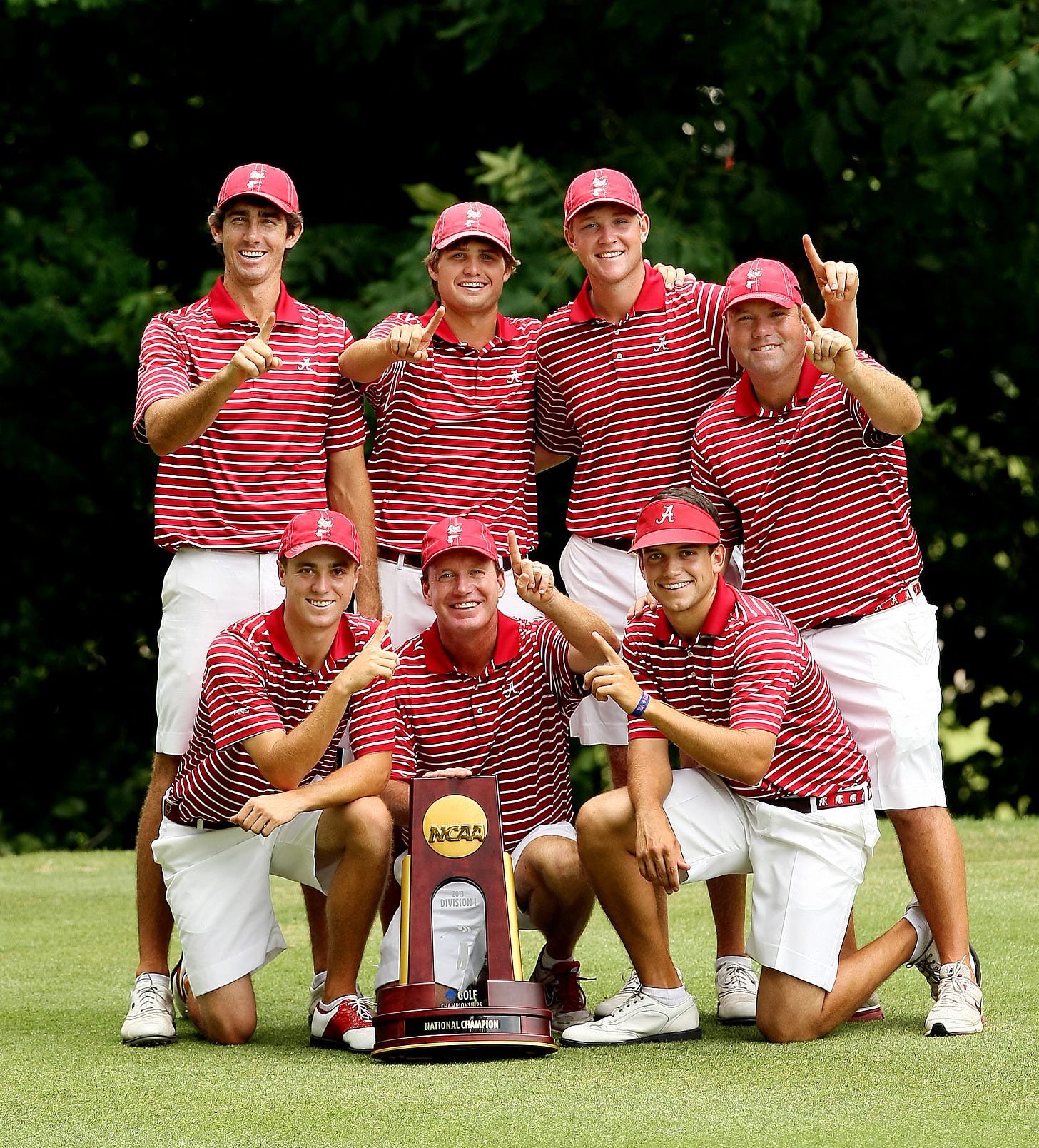This is part of a series on the Men’s Collegiate Championships
NCAA Championship Era: 1939-NOW
REGIONAL ROUND-UP
Gone are the days of NCAA online streaming, college golf has hit the mainstream golf media and gaining more casual fans than ever. Even the Regional announcements are now getting their own coverage, with experts who had covered the game for a while now getting in front of the camera to discuss the NCAA golf postseason much the same way they would a pro tour major. Shortly after the announcement, Golf Channel’s Steve Burkowski and Gary Williams discussed their 2014 Regional picks which can be seen here.
COLUMBIA REGIONAL
The 2 (Virginia) and 5 seed (Arizona State) teams were left on the outside looking in as Missouri and Iowa State jumped up to take their spots in the NCAA championship. The latter posted an incredible final round 270 (-18) to go from outside the cut to in by an impressive 12 strokes. Missouri’s Emilio Cuartero won medalist honors with a final round 65, beating out a group that included teammate Hunter Kraus (final round 69) and a pair of Oklahoma State Cowboys Talor Gooch [Ok St] (66) and Jordan Niebrugge (68). Virginia’s Denny McCarthy, one of the sensational players in the historic freshman class that included Justin Thomas and Jordan Spieth, finished T6 which sent him to nationals as an individual.
SAN ANTONIO REGIONAL
According to GolfStat rankings, TCU’s Julien Brun was the third best player in the field, but starting out with back to back 67s helped propel him to medalist honors and exemption into nationals as an individual as TCU finished just outside the cutline. This is where things go interesting, though, as Brun declined the opportunity to play in the championship and instead honoring a commitment to play in an upcoming pro event. In his place, UCF’s Ricardo Gouveia got to go to nationals after his team had a surprising 7th place finish. Finishing in 2nd place instead of the 2 seed UCF was the surprise 8 seeded Georgia State. The 6 seed SMU team finished 4th to also advance, doing the reverse of the previous year where they were seeded #4 but just missed out by finishing 6th. The 5 seed (South Florida) wasn’t ever in contention to advance.
AUBURN REGIONAL
Playing in enemy territory close to home, Alabama rolled to a third straight Regional title. Only 4 strokes prevented a Bama player - in this case Cory Whitsett, from winning medalist honors for the third straight year as well. Instead, it was Austin Peay State’s Marco Iten that took those honors and moving on as an individual. Curiously, another 5 seed failed to advance as New Mexico missed qualifying by a single stroke.
RALEIGH REGIONAL
Jonathan Sanders [Washington] shot a final round 67 to beat out Ollie Schneiderjans [Georgia Tech] by three strokes for medalist honors. All five Georgia Tech players finished T15 or better, with four finishing inside the top 10, giving them an easy victory. The 5 seed that failed to qualify in this Regional was Mercer, and instead it was the 6 seeded Kentucky who advanced.
SUGAR GROVE REGIONAL
California, the only #1 seed team to not win their Regional, just managed to sneak in at T4 despite a final round 303 thanks in part to Clemson’s 307 which dropped them 3 spots to miss qualifying by 2 strokes. Anthony Paolucci, one of the fab five freshman of the 2011 recruit class, shot a final round 69 but finished runner-up by four strokes behind fellow junior Brian Campbell [Illinois]. The 5 seed was UNLV, but the 8 seeded Purdue was the one who advanced.
EUGENE REGIONAL
Patrick Rodgers finished as the only man under par for the tournament, earning his 6th win of the season. With this win Rodgers reached an important milestone: tying Tiger Woods with 11 collegiate wins. After his incredible season, Rodgers would beat out teammate Cameron Wilson for several prestigious awards including the Nicklaus Award, Hogan Award, and Haskins Award. The 5th seeded Baylor Bears fell way out of contention in a hurry while 7th seeded Oregon Ducks were only 1 stroke away from tying Stanford for the team victory.
Intercollegiate Championship #117: May 24-28, 2014
The 2014 championship marked several significant milestones, the most visible being the extensive TV coverage from Golf Channel. This wasn’t the first time that college golf had been on TV, but Golf Channel had big plans for covering the final round of (individual) stroke play, most of the Semifinal matches, and then a significant portion of the Finals match.

Host: Prairie Dunes (Kansas)
This is the first (and so far only) time that the famous Hutchinson, Kansas course hosted the NCAA championship. Members of the Big 12 conference were very familiar with the course, however, which had hosted the championship 11 times between 1997 and 2014. The previous year (2013) Texas was able to outlast Oklahoma State on the way to the team title. Likewise, Texas’s Brandon Stone took medalist honors by 3 strokes over Oklahoma State’s Talor Gooch.
Format
The NCAA Golf Committee met after the 2013 championship and decided on some major changes starting in 2014. Their plan was to highlight the individual champion, however their methods for doing so were not exactly universally commended. The biggest change was to bring back a fourth round of stroke play which would be aired on TV, but would only be for the top 40 individuals (plus ties). The cut to determine the top 8 teams advancing to match play was still scheduled for 54 holes, leaving players on those teams not in the running for the individual title to essentially take a day off. While several prominent coaches were quoted as being in favor of having a championship decided in 72 holes, some lamented that being individuals-only for that last round wasn’t the right approach and predicted that there might be a rash of one-day illnesses or minor injuries for those individuals not within realistic striking distance. We’ll never know if this fear was justified as Mother Nature had other plans. Significant weather delays in the opening rounds meant that tournament officials had to call an audible and get creative just to get in 54 holes. Because the delay brought the 54-hole cut for the top 8 teams to TV, the NCAA Committee realized how compelling the “Race to the Eight” actually was and voted after the championship to keep the fourth round but alter it so that starting in 2015 the top 15 teams (cut after 54-holes) would be fighting for the 8 match play spots. With less teams in the field, this change provided the most practical way to bring the top teams and individuals into the TV window by giving them later tee times.
Team and Individual stroke play
Day 1 (Friday) = 18 holes
**rain forces almost a complete washout with only a few teams able to complete even 9 holes
Day 2 (Saturday) = 18 holes
Completing 1st round and some of the 2nd round
Day 3 (Sunday) = 18 holes
Completing the 2nd round
Day 4 (Monday) = 18 holes
**54 holes determines Individual championship
**Cut to top 8 teams
Team match play
Day 4 (Tuesday) = 2 matches
Quarterfinals
Semifinals
Day 5 (Wednesday) = Finals
Results
Individual Medalist/Champ: *Cameron Wilson [Stanford]
It took three days for all of the teams to complete 36 holes, and throughout most of it there was a general sense of confusion on where everyone stood. As we get into more detail in the team section, Stanford was one of just six teams to complete their 36 holes by Saturday afternoon, having played all 36 that day. This turned out fairly well as not only did they occupy the top spot on the team leaderboard, Cameron Wilson held the same spot on the individual side with a 71-63=134 (-6), just 1 stroke ahead of teammate (and tournament favorite) Patrick Rodgers who went 67-68. Due to the crazy scheduling gymnastics, Stanford had to sit on these leads all through Sunday and Monday morning as teams finished their 2nd round and those in the back half of the standings started their 3rd round. Georgia Tech’s Ollie Schniederjans started the third round as one of five players in 3rd place just two shots back, teeing off hole #1 about an hour ahead of the Stanford leaders. Scores ebbed and flowed at the top of the leaderboard as they tend to do on that final day, and a birdie on the 17th hole got Schniederjans to -2 for the day to tie Wilson. The tie didn’t last long, however, as Wilson answered with a birdie of his own on the same hole while Schniederjans finished the round with a par. It all came down to the last hole where Wilson’s makeable par putt to win the individual title slid just past the hole. A tap in bogey meant a playoff between Wilson and Schneiderjans who both finished 206 (-4). The two matched pars on first hole #18 and then hole #10 before Wilson finally got a birdie putt to drop on the third playoff hole (#17) to capture the individual title. The win capped off a great year for Wilson in which he finished as a finalist for numerous awards, and would go on to earn the Palmer Award.
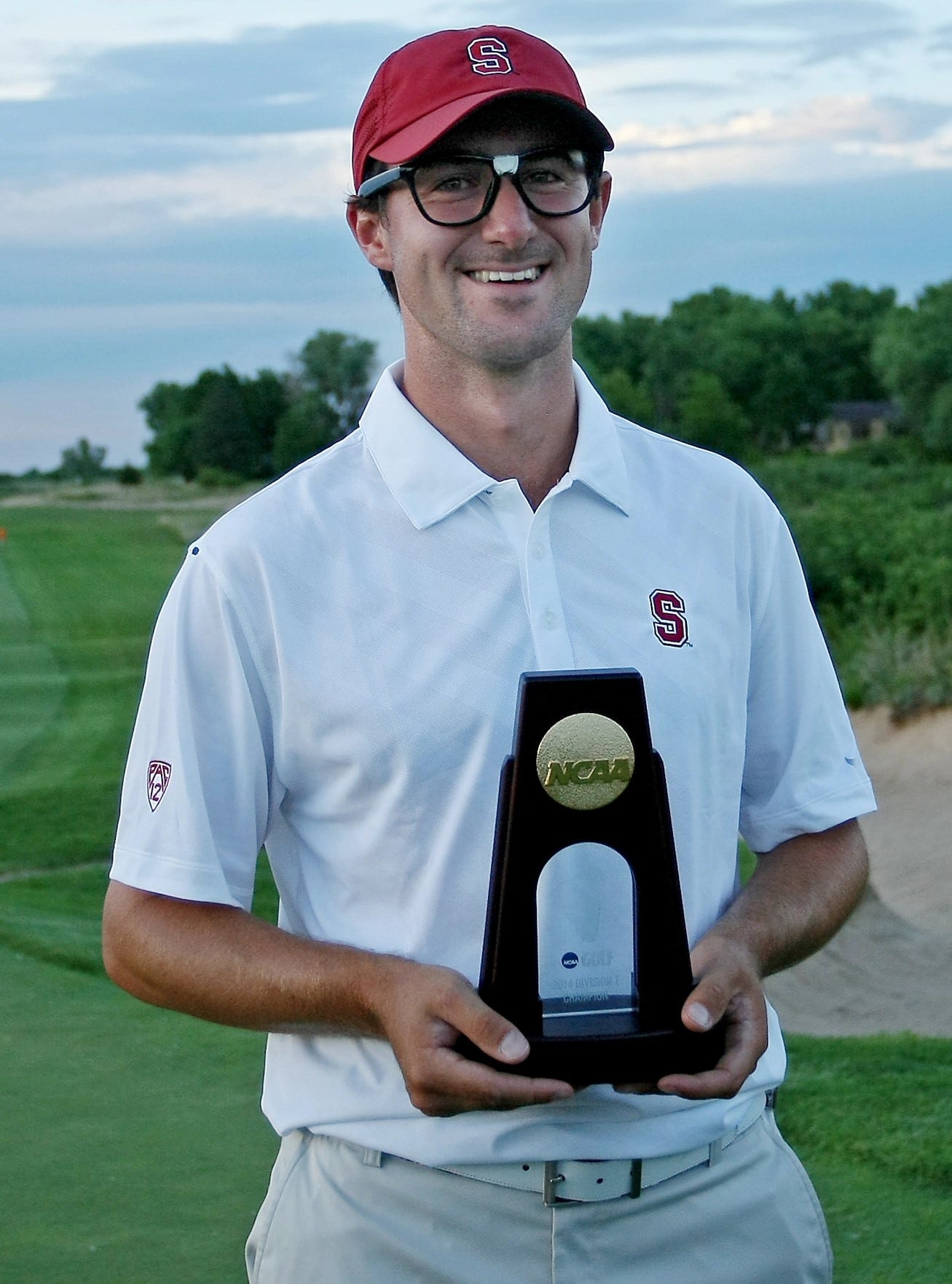
(Stanford Athletics via GolfWeek) 
(via GolfStat)
Team Stroke Play: (highlights can be see here)
Prairie Dunes is known for is brutal winds, but it was the rain that wreaked havoc on the first round of the NCAA championships. The day started with a 40 minute delay before a single shot had even been struck. The morning wave was barely able to get started before the horn sounded at 10:00 a.m. to begin a second delay that lasted five hours. Play resumed around 3 p.m. but was halted again around 4:30. Eventually play was called for the day, leaving a majority of the morning wave shy of finishing even 9 holes; the afternoon wave hadn’t even had the chance to get out and warm up, instead spending the day cooped up in the hotel venturing out out only for food and even a movie. Saturday was busy as tournament officials got creative. The afternoon wave, who were unable to get out on the course at all the previous day, got off to an early start so that they could try to get in 36 holes, while the morning wave came out to finish their first round and then spend the rest of the day back in the hotel. When darkness finally halted play around 9:30 p.m. only 6 of the 30 teams had been able to complete 36 holes. The day was mostly cloudy and the wind was light the entire day, seemingly leaving the greens soft and vulnerable to low scores. Top teams Stanford (-12) and Alabama (-8) took advantage for an early lead to sit atop a leaderboard mixed of teams having posted anywhere from 18-36 hole scores. Sunday (the third day) morning brought with it wind and another hour long delay. Scores soared for the 24 teams who struggled through the day to complete their second round. Fearing more possible weather and the reality that their plans had fallen through, the committee made a couple of difficult decisions. First, the planned fourth individual-only round was scrapped entirely. Teams who had finished 36 holes in positions 16-30 were sent out late on Sunday (after 4:30 p.m.) in a shotgun start to get in as many of their third round as possible. Those teams then returned the next morning (Monday) to finish before the remaining teams and individuals were finally sent off split tees Monday afternoon to finish the 54-hole stroke play portion of the tournament. The three teams atop the leaderboard through 36-holes - Stanford (-12), Alabama (-8), and Oklahoma State (-4) - were in the second-to-last group that went off the front 9 at 2 p.m. Monday. This shift proved fateful as the scheduled TV window was able to capture not only the dramatic conclusion to the individual title that they had originally hoped for (on the back 9), but also the unexpected drama around the teams vying for the final spots inside the match play cutline (on the front 9). Illinois made the turn still needing to make up ground on Oklahoma and South Carolina. While Illinois’ other three counting scores closed out their back 9 at even par, Brian Campbell closed with a remarkable 30 (-5) that tied the same course record 63 that Cameron Wilson had reached in round 2, and posted the number to meet around the team cutline (+5). At the same time - finishing on 18 green - SMU counting scores dropped 3 strokes on the final hole to drop down to that same +5 number. The final groups in the running for the match play spots were UCLA/South Carolina/Oklahoma which were finishing behind Illinois on the front side. South Carolina players had played well enough to be within the cut line until the final two holes were the counting scores dropped a combined 5 strokes to finish 1 behind Illinois/SMU. Meanwhile, Oklahoma spiraled and dropped a combined 10 strokes on their back 9 to finish 9 strokes outside the cut line.

(via GolfStat) Team Match Play:
Quarterfinals: (highlights can be seen here and here)
By virtue of the tie-breaker with LSU1, Alabama ended up the 2 seed which set up an interesting match with SMU who had also won their tie-breaker in order to get the 7 seed. Bama was trying to gain their second title in a row, an achievement last made when Coach Josh Gregory led Augusta to consecutive championships in 2010 and 2011. Coach Gregory took the head coaching position at his alma mater SMU for the 2011-12 season, and in just a few short years was once again in the match play portion of the NCAA championship. Bobby Wyatt got Bama off to a quick start to put the first point up on the board while freshman sensation Robby Shelton flipped his match on the back 9 to get the second point. SMU’s top two players, Bryson DeChambeau and Harry Higgs, were leading their matches and looking to claim two points to tie the team match when Bama’s Cory Whitsett ended the anchor match early with a 5&4 victory. The final two matches on the course were conceded the final holes, making the final total 3-2.
As the 3 seed, LSU faced off against UCLA in what turned out to be a fairly one-sided matchup. The middle three matches went mostly LSU’s way, giving them a 2-1 lead. The lead match between LSU’s Curtis Thompson and UCLA’s Preston Valder was tied late until Thompson eagled his 16th hole (hole #7), giving his a 1up lead which he finished with. With the three points needed, the final match on the course where Zach Wright [LSU] was dormie 2 was halved/conceded, which made the final score 4-1 for LSU.
By virtue of their drop score being a 0 from a DQ in the final round, Illinois lost the tie-breaker with SMU and therefore got the 8 seed and the “honor” of going up against the team “winners”, 1 seed Stanford. The matches were all close with each team taking both a 3&2 and 1up match victory. The anchor match between medalist Cameron Wilson [Stanford] and Alex Burge [Illinois] went back and forth until Wilson made a two-putt birdie on the 17th hole to take the lead for good, sending Stanford to the Semifinals.
Highlights from their match can be viewed here
The Oklahoma State - Georgia Tech match looks one-sided based on the results, but the truth is that Tech just ran out of holes. Oklahoma State had multiple hole leads in the first three matches out as they made the turn (all of them went off the back 9), but all of them made it to the 17th (8th) green with two ending on the 18th (9th). The final two matches still on the course were ended at that point, giving Ok St a 4th point and both teams a halved point as Ollie Schneiderjans [GT] and Ian Davis [Ok St] were tied while sitting in the fairway on hole #8 when things officially concluded. Besides just the golf on the course, this match was special for the connections between the two programs as Georgia Tech’s Coach Bruce Heppler was the assistant coach at Oklahoma State when Alan Bratton (now head coach at his alma mater) helped lead the 1995 team to a national championship over Stanford (and a freshman named Tiger Woods).
Barely a pause for lunch and a quick breather before they had to go back out on the course and do it again
Highlights from the Bama/LSU match here
The Alabama - LSU matchup was a pairing of the top two teams in the SEC, Alabama having recently won their third straight conference title while LSU finished runner-up. It also guaranteed that an SEC team would be in the Finals for the 5th time in the 6 years that team match play had been used. Coach Chuck Winstead knew he had a good team - they would go on to win the championship next year leveraging much of the experience learned on this day - which got off to a good start, but as the matches wore on the Tide were able to take back control. First, Wyatt was able to close out Ben Taylor 3&2. Next, freshman Robby Shelton was able to overcome another early deficit to defeat Stewart Jolly 2&1 with back-to-back birdies on the 16th and 17th holes. The fourth match proved the deciding point when Mullinax closed out Curtis Thompson 4&2. Lovelady was 1up on Smylie Kaufman on the 17th hole when play was halted, giving the Tide a 4th point, and Zach Wright was 1up on Whitsett on the 15th hole which gave LSU their lone point.
Highlights from the match can be viewed here
TV audiences tuning in for Golf Channel’s afternoon coverage were treated to an intriguing matchup between Stanford and Oklahoma State. Four of the five matches were tied at the turn, with Jordan Niebrugge [Ok St] leading fellow Walker Cupper Patrick Rodgers [Stanford] by one hole in the fifth match. The second match out provided the first point when Cameron Wilson closed out Ian Davis (who was still feeling ill as he had all day) 4&2. Oklahoma State tied up the points 1-1 when Zach Olsen closed out David Boote 3&2 (fourth match out). The first match out proved the most exciting with Stanford freshman Maverick McNealy making a crucial par on 18 to send his match with senior Talor Gooch into extra holes. Their playoff proved to be the longest in NCAA history, finally ending on the 21st hole when Gooch sank a curling 30-foot birdie and McNealy missed his 10-footer to extend the match. Simultaneous to Rodgers closing out a 2&1 win over Niebrugge on the 17th hole, Stanford’s Viraat Badhwar had a key birdie putt on the 18th hole of his match with Wyndham Clark to extend the match. Badhwar’s putt slid past the hole, sending Oklahoma State into the Finals for the first time since their 2010 loss to Augusta.
Highlights from their match can be viewed here
Finals: Alabama (2 NCAA, 2 overall)
So many storylines between these two teams, but perhaps the second biggest (behind the Bama repeat) was the fact that Alabama assistant coach Mike McGraw was now facing his former team for the national title just 11 months after making the change from orange to crimson (more on this below)
Preview can be seen here
Preview interview with Coach Bratton can be seen here
Pairing unveiling on Golf Channel can be seen here
The Bobby Wyatt - Talor Gooch match kicked off things in a hurry, just the way Wyatt liked to play. After losing the first hole, Wyatt aced the second to tie the match. A par on the third hole gave Wyatt his first lead which he never relinquished. Not only did he finish early with a 3&2 win, Wyatt put a quick point on the board for Bama.
The Robby Shelton - Zach Olsen match was taken all the way to the 18th hole where Shelton closed out the fellow freshman when he calmly sank his ~15 foot birdie putt. Since Olsen’s own ~7 foot birdie putt was conceded, there ended up being a total of twenty-one “3”s combined on the two scorecards which might be a record according to anecdotal conversation between Coach Seawell and Coach McGraw on the latter’s Better Than I Found It podcast (see below). Record or not, the match was absolutely incredible. Olsen lead at the turn by just one hole after shooting a 31 (to Shelton’s 33) and then lost despite shooting only 64 (to Shelton’s 63)! Shelton, who won medalist honors 3 times this season as well as winning 3 matches in the NCAA championship, was an easy selection for the Mickelson Freshman of the Year Award.
The Tom Lovelady - Wyndham Clark match was well in hand for Clark by the turn. The lead stretched to 5 with a birdie on the 10th hole, but Lovelady made a charge back with wins on 12, 13, and 14. A bogey on 17 sealed Lovelady’s fate, earning Oklahoma State their first point.
The Trey Mullinax - Ian Davis match was similar to the Lovelady/Clark match except in favor of the Tide. Mullinax’s lead peaked at 4 as they made the turn, but steady play from Davis and a series of bogeys from Mullinax got the lead down to just 1 with 5 holes to play. The par 5 17th hole had already been the site of the individual title and incredibly would be the site of the team title as well. After sticking his second shot on the back of the green, Mullinax had a tricky downhill eagle putt that had as much of a chance of running off the green as it did actually stopping by the hole. As seen below, the ball miraculously caught the lip of the cup and fell in, earning Alabama their third point and securing the championship. Mullinax told school reporters
"Hitting that putt on 17 is something that I think you always dream about," Mullinax said. "You've got a putt to win the national championship, and to have it go in, and to share that with Coach Seawell, who's mentored me for four years now and has done so much for me in my golf career that I can't tell him thank you enough. He means the world to me, and to have him by my side and my teammates today was just really special."
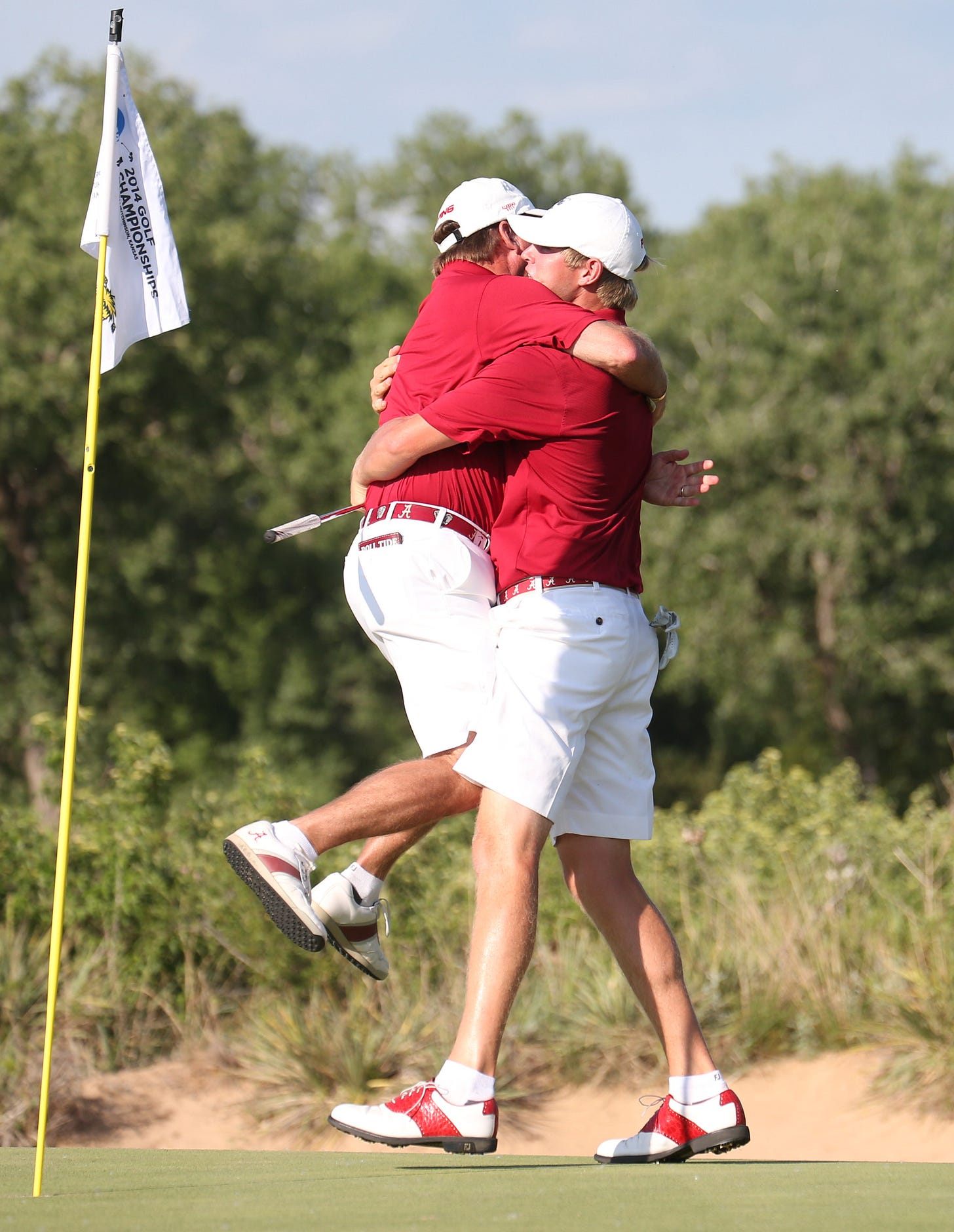
Coach Seawell jumps into the arms of Trey Mullinax on the 17th green after Mullinax sank the eagle putt to secure Bama’s second consecutive title (Alabama Athletics) The Cory Whitsett - Jordan Niebrugge match was a heavyweight battle between two Walker Cuppers, and it lived up to that billing. Only twice was Niebrugge able to take a one hole lead, but both times Whitsett was able to square the match on the next hole. Whitsett took his first lead of the day with a birdie on the 14th and then backed that up with another birdie on the 15th to increase the lead to 2 holes. The players sat on the 17th fairway and watched Bama’s Mullinax sink the winning eagle putt, which made the result of their match moot. The hole was officially halved as they shook hands, going down as a 2&1 win for Whitsett to make his NCAA match play record 7-2. Whitsett will go down as one of the best NCAA championship match players in college golf history.
Some final highlights can be seen here and here
EXTRA HOLES: The Alabama Run (2011-2014)
In order to better understand the context of the Bama run of three straight Finals appearances from 2012-14, we first need to take a look at the heartache experienced in 2011. Just months after a devastating tornado ripped through Tuscaloosa - narrowly missing the campus and football stadium but wiping out many homes as it hit the main intersection right next to the hospital - Alabama found themselves in another area of the country familiar with tornadoes, Stillwater (OK) site of the 2011 NCAA golf championship.
The Tide were a young team with three incredible freshmen in Cory Whitsett, Bobby Wyatt, and Trey Mullinax, but expectations were high. This team, which also included outgoing senior Bud Cauley and junior Hunter Hamrick, had won 5 tournaments and finished 2nd in the SEC. Through two rounds in the NCAA championship, the 3rd ranked Tide were sitting pretty in the 5th spot, just 7 shots behind 1st place Georgia Tech and 10 strokes ahead of the cutline. Karsten Creek is a famously difficult course and has been used as a verb by many golfers over the year, so when Alabama walked off the course having shot 316 (+28) in the final stroke play round, people absolutely understood when they said they “got Karsten Creeked.” Hunter Hamerick, who had spent time in the hospital overnight with mono, somehow willed his body around the golf course and posted Alabama’s best score, a 76. Adding to the misery of the moment was the fact that they had only missed the cut off for match play by 7 strokes. On Coach McGraw’s podcast (see above), Coach Seawell described the heart breaking hours afterwards where out of that incredible low point, something special was born.
Quick aside: there is an interesting connection with the eventual champions in the fact that Coach Jay Seawell had coached Augusta (State) from 1998-2002 before heading to Tuscaloosa for the Alabama coaching job.
Joining the team for the 2011-12 season were two of the top recruits in the country - Justin Thomas and Tom Lovelady - both of whom would play critical roles in the upcoming seasons. Justin Thomas stood out among a freshman class that was historically good, and boy did he not disappoint. JT won 4 tournaments in his freshman campaign including the SEC and Regional titles just ahead of teammate Bobby Wyatt. For his accomplishments, Thomas earned numerous awards including the Mickelson Award (top Freshman), Nicklaus Award (top GCAA player), and Haskins Award (top player). As a team, the Crimson Tide won 5 tournament titles and the stroke play portion of the NCAA Championship, making them the 1 seed. For all of the accolades though, there was only one thing Justin Thomas and the Tide missed: the national championship. Their team NCAA runner-up trophy joined the one from their 1975 NCAA third place finish - the year Jerry Pate finished runner-up to Jay Haas who helped Wake Forest repeat in historic fashion. In 2022, Golf Channel’s Brentley Romine put together an incredible three-part 10-year retrospective on the 2012 championship which is far more comprehensive than we could ever hope to cover here. When you have time, please check them all out here, here, and here.
Expectations were even higher for 2012-13 season, yet the Tide still managed to meet and even surpass them. The team won 7 tournaments - repeating as both SEC and Regional champions - while three different players medaled in various tournament: Justin Thomas (2), Cory Whitsett (2), and Scott Strohmeyer (1). At the NCAA championship, Alabama tied with reigning champion Texas (now without Jordan Spieth) for 3rd in the stroke play portion. Winning the tie-breaker for the 3 seed was huge for Bama because it put them on the other side of the bracket from top seed California, winner of 11 tournaments this season and considered by many to be one of the best college teams in the last 20 years (perhaps ever). Illinois had a somewhat surprising victory over Texas and then took down Goliath Cal. Alabama met Illinois in the Finals after beating first New Mexico then Georgia Tech by matching 4-1 scores. Bobby Wyatt scored a quick win in his Finals match from his familiar leadoff spot. Likewise, Whitsett scored a point in the anchor match. Just a few minutes later Strohmeyer scored the decisive 3rd point, earning Alabama its first ever men’s national championship outside of football.
It’s hard to put into words just how much winning the 2013 championship meant for the Alabama Crimson Tide, especially Cory Whitsett. This (partial) feature from Golf Channel’s Steve Burkowski captures the emotional redemption story of Alabama golf.
It’s also hard to follow up a championship season with another one. Since Wake Forest did it in 1974-75, only two other teams had successfully defended their title: Houston (1984-85) and Augusta (2010-11). Coach Seawell’s 2013-14 team also looked a little different, losing Justin Thomas, Lee Knox, and Scott Strohmeyer to the pro ranks as well as assistant coach Rob Bradley who took the head coaching position at Purdue. Joining the core championship team from 2013 - Cory Whitsett, Bobby Wyatt, and Trey Mullinax - was the top freshman recruit in the nation, Robby Shelton, as well as arguably the top coaching free-agent, Mike McGraw, formally of Oklahoma State. Once again the bar was raised as this year’s team accumulated 9 team wins that included a perfect Fall season - giving them a record 11 straight victories going back to March - as well as their third straight SEC and Regional titles. With their other finishes being 2nd, T4, and 2nd - along with the T2 finish in the NCAA stroke play portion - this Alabama team also appears on the short list of statistically best men’s college teams in (at least) the last two decades.
One final note on this championship: Alabama became the first team in the short history of the NCAA match play format (starting 2009) to reach the Finals more than twice, a feat that as of 2022 had only been accomplished by Oklahoma State and Texas who each had a 1-2 record in their Final appearances.
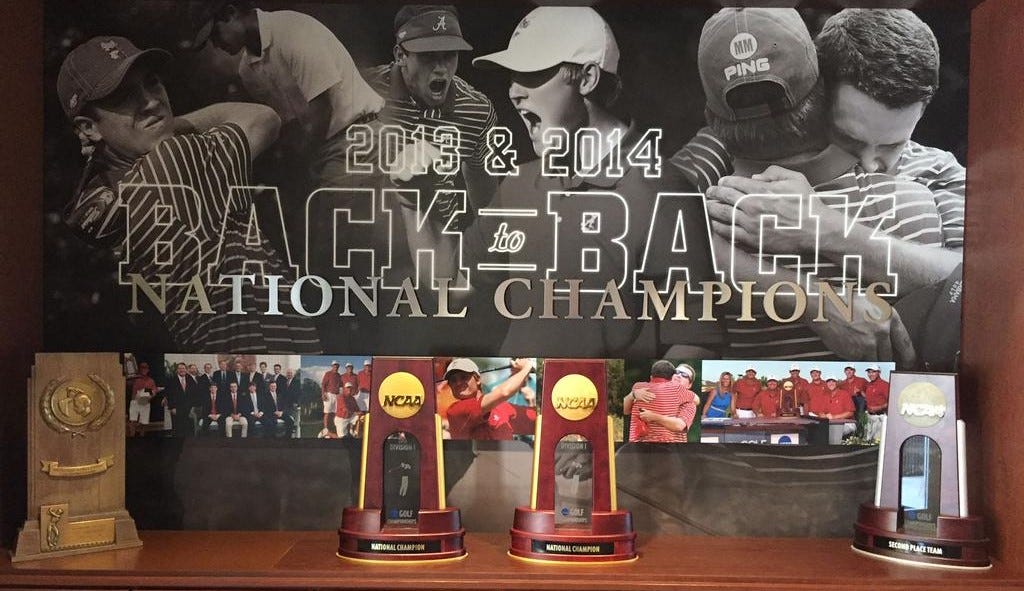
For his team’s accomplishments in the 2013-14 season, Coach Seawell earned the Dave Williams Coach of the Year Award, the first of his career. In 2016, the totality of Coach Seawell’s career to that point earned him induction into the GCAA Hall of Fame. The best part, two familiar peers were joining him - Coach McGraw and Coach Dick Spybey who was Alabama’s coach before Seawell. Three great coaches tied to Alabama helped make up a stellar group in the 2016 HoF class:
Up Next:
In the next post we will cover the 2018 championship where Oklahoma State looks to get revenge against Alabama in the Finals at their home course, Karsten Creek. This OSU team was considered the favorites from the very beginning of the year, but there was a major historical jinx standing in the way.
The first tie-breaker was the 54-hole total of all of the drop scores which came out to be 221 for both teams. The second tie-breaker, the 54-hole total for he best scores each round, went in favor over Alabama 199 to 203.




